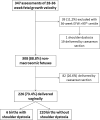Accelerated fetal growth velocity across the third trimester is associated with increased shoulder dystocia risk among fetuses who are not large-for-gestational-age: A prospective observational cohort study
- PMID: 34669758
- PMCID: PMC8528331
- DOI: 10.1371/journal.pone.0258634
Accelerated fetal growth velocity across the third trimester is associated with increased shoulder dystocia risk among fetuses who are not large-for-gestational-age: A prospective observational cohort study
Abstract
Objective: To investigate whether fetuses with accelerated third trimester growth velocity are at increased risk of shoulder dystocia, even when they are not large-for-gestational-age (LGA; estimated fetal weight (EFW) >95th centile).
Methods: Fetal growth velocity and birth outcome data were prospectively collected from 347 nulliparous women. Each had blinded ultrasound biometry performed at 28 and 36 weeks' gestation. Change in EFW and abdominal circumference (AC) centiles between 28-36 weeks were calculated, standardised over exactly eight weeks. We examined the odds of shoulder dystocia with increasing EFW and AC growth velocities among women with 36-week EFW ≤95th centile (non-LGA), who went on to have a vaginal birth. We then examined the relative risk (RR) of shoulder dystocia in cases of accelerated EFW and AC growth velocities (>30 centiles gained). Finally, we compared the predictive performances of accelerated fetal growth velocities to 36-week EFW >95th centile for shoulder dystocia among the cohort planned for vaginal birth.
Results: Of the 226 participants who had EFW ≤95th centile at 36-week ultrasound and birthed vaginally, six (2.7%) had shoulder dystocia. For each one centile increase in EFW between 28-36 weeks, the odds of shoulder dystocia increased by 8% (odds ratio (OR [95% Confidence Interval (CI)]) = 1.08 [1.04-1.12], p<0.001). For each one centile increase in AC between 28-36 weeks, the odds of shoulder dystocia increased by 9% (OR[95%CI] = 1.09 [1.05-1.12], p<0.001). When compared to the rest of the cohort with normal growth velocity, accelerated EFW and AC velocities were associated with increased relative risks of shoulder dystocia (RR[95%CI] = 7.3 [1.9-20.6], p = 0.03 and 4.8 [1.7-9.4], p = 0.02 respectively). Accelerated EFW or AC velocities predicted shoulder dystocia with higher sensitivity and positive predictive value than 36-week EFW >95th centile.
Conclusions: Accelerated fetal growth velocities between 28-36 weeks' gestation are associated with increased risk of shoulder dystocia, and may predict shoulder dystocia risk better than the commonly used threshold of 36-week EFW >95th centile.
Conflict of interest statement
The authors have declared that no competing interests exist.
Similar articles
-
Prediction of large-for-gestational-age neonate by routine third-trimester ultrasound.Ultrasound Obstet Gynecol. 2019 Sep;54(3):326-333. doi: 10.1002/uog.20377. Epub 2019 Jul 23. Ultrasound Obstet Gynecol. 2019. PMID: 31236963
-
Reduced growth velocity from the mid-trimester is associated with placental insufficiency in fetuses born at a normal birthweight.BMC Med. 2020 Dec 24;18(1):395. doi: 10.1186/s12916-020-01869-3. BMC Med. 2020. PMID: 33357243 Free PMC article.
-
Reduced growth velocity across the third trimester is associated with placental insufficiency in fetuses born at a normal birthweight: a prospective cohort study.BMC Med. 2017 Aug 31;15(1):164. doi: 10.1186/s12916-017-0928-z. BMC Med. 2017. PMID: 28854913 Free PMC article.
-
Universal third-trimester ultrasonic screening using fetal macrosomia in the prediction of adverse perinatal outcome: A systematic review and meta-analysis of diagnostic test accuracy.PLoS Med. 2020 Oct 13;17(10):e1003190. doi: 10.1371/journal.pmed.1003190. eCollection 2020 Oct. PLoS Med. 2020. PMID: 33048935 Free PMC article.
-
The test accuracy of antenatal ultrasound definitions of fetal macrosomia to predict birth injury: A systematic review.Eur J Obstet Gynecol Reprod Biol. 2020 Mar;246:79-85. doi: 10.1016/j.ejogrb.2020.01.019. Epub 2020 Jan 16. Eur J Obstet Gynecol Reprod Biol. 2020. PMID: 31978846
Cited by
-
Fetal Growth Velocity-A Breakthrough in Intrauterine Growth Assessment?J Clin Med. 2024 Jun 29;13(13):3842. doi: 10.3390/jcm13133842. J Clin Med. 2024. PMID: 38999408 Free PMC article. Review.
-
Late pregnancy ultrasound parameters identifying fetuses at risk of adverse perinatal outcomes: a protocol for a systematic review of systematic reviews.BMJ Open. 2022 Mar 23;12(3):e058293. doi: 10.1136/bmjopen-2021-058293. BMJ Open. 2022. PMID: 35321896 Free PMC article.
-
Shoulder dystocia by severity in families: A nationwide population study.Acta Obstet Gynecol Scand. 2024 Oct;103(10):1955-1964. doi: 10.1111/aogs.14766. Epub 2024 Jan 7. Acta Obstet Gynecol Scand. 2024. PMID: 38186187 Free PMC article.
-
Analytical Comparison of Risk Prediction Models for the Onset of Macrosomia Based on Three Statistical Methods.Dis Markers. 2022 Sep 10;2022:9073043. doi: 10.1155/2022/9073043. eCollection 2022. Dis Markers. 2022. PMID: 36124028 Free PMC article.
References
-
- King JR, Korst LM, Miller DA, Ouzounian JG. Increased composite maternal and neonatal morbidity associated with ultrasonographically suspected fetal macrosomia. The journal of maternal-fetal & neonatal medicine: the official journal of the European Association of Perinatal Medicine, the Federation of Asia and Oceania Perinatal Societies, the International Society of Perinatal Obstet. 2012;25(10):1953–9. Epub 2012/03/24. doi: 10.3109/14767058.2012.674990 . - DOI - PubMed
-
- Stotland NE, Caughey AB, Breed EM, Escobar GJ. Risk factors and obstetric complications associated with macrosomia. International journal of gynaecology and obstetrics: the official organ of the International Federation of Gynaecology and Obstetrics. 2004;87(3):220–6. Epub 2004/11/19. doi: 10.1016/j.ijgo.2004.08.010 . - DOI - PubMed
Publication types
MeSH terms
LinkOut - more resources
Full Text Sources


